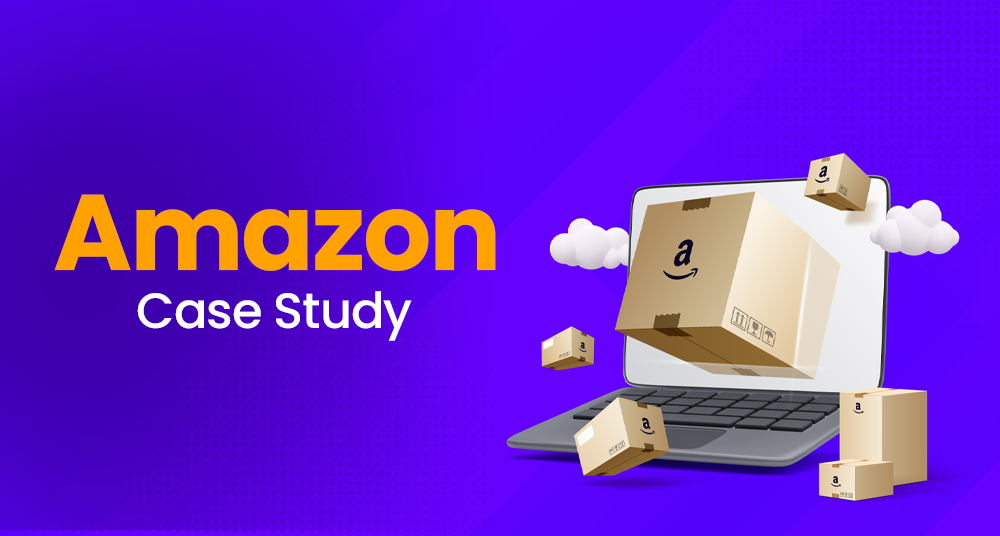Amazon is more than just an e-commerce platform — it’s a global force that has redefined retail, technology, and digital innovation. Founded by Jeff Bezos in 1994 as an online bookstore, Amazon has grown into a trillion-dollar enterprise operating across multiple industries — e-commerce, cloud computing, entertainment, advertising, logistics, and AI.
By 2025, Amazon touches nearly every part of the digital economy, setting new benchmarks in convenience, customer experience, and innovation.
Studying Amazon’s success offers valuable lessons on how vision, data, and technology can transform industries and customer behavior worldwide.
Company Overview
From a modest garage startup in Seattle, Amazon has evolved into one of the world’s largest and most influential corporations.
Operating in more than 200 countries, Amazon serves hundreds of millions of customers daily across diverse verticals.
Core Business Segments
- Amazon Marketplace: The world’s largest e-commerce platform, empowering millions of third-party sellers.
- Amazon Web Services (AWS): Global leader in cloud computing, powering businesses and governments worldwide.
- Amazon Prime: A subscription ecosystem offering fast delivery, exclusive content, and digital benefits.
- Amazon Advertising: A high-growth segment driving billions in annual revenue.
- Devices & AI: Alexa, Echo, and other smart products redefining connected living.
Each division strengthens the other — forming a self-sustaining ecosystem of commerce, technology, and entertainment.
Amazon’s Mission & Vision
Amazon’s mission has remained consistent since inception:
“To be Earth’s most customer-centric company.”
Its vision extends beyond e-commerce — it’s about building technology and systems that make life simpler, faster, and better for customers everywhere.
Every innovation, from one-click ordering to drone delivery, reflects this mission to place customer convenience above everything else.
Core Business Strategies
Amazon’s rise is built on clear strategic pillars that guide every decision and innovation:
- Customer Obsession: Prioritizing long-term trust and satisfaction over short-term profit.
- Operational Excellence: Constantly optimizing logistics, fulfillment, and cost efficiency.
- Technology Leadership: Investing heavily in AI, data science, and automation.
- Ecosystem Expansion: Building interconnected services (Prime, AWS, Ads) that support each other.
- Innovation Culture: Encouraging experimentation and learning from failure.
These strategies allow Amazon to operate at massive scale while staying agile and customer-focused.
Amazon’s Business-Level Strategy
Amazon’s business strategy revolves around differentiation through innovation, technology, and global reach.
- E-commerce Dominance: Leveraging logistics and scale for product variety and low prices.
- Cloud Leadership (AWS): Diversifying revenue through the world’s most profitable cloud infrastructure.
- Subscription Ecosystem: Prime drives loyalty and recurring revenue.
- Innovation Edge: Constantly developing new tech (Alexa, cashier-less stores, AI tools).
- Localization: Adapting products and services for regional markets worldwide.
By combining personalization with scale, Amazon achieves both global impact and individual relevance.
Amazon’s Sales and Revenue Strategy
Amazon’s revenue engine is powered by a multi-channel ecosystem rather than a single product line.
- Diversified Revenue Streams: Retail, AWS, Ads, Devices, Prime.
- Dynamic Pricing: AI algorithms adjust prices in real time to maximize conversion.
- Personalized Recommendations: Contribute to over 30% of total sales.
- Prime Loyalty Model: Encourages repeat engagement and higher lifetime value.
- Logistics Mastery: In-house fulfillment and delivery innovations ensure speed and reliability.
This blend of technology and strategy makes Amazon’s growth consistent and resilient.
Marketing & Digital Strategy
Amazon’s marketing is data-driven, customer-focused, and creative.
- Data Intelligence: Every action on the platform refines Amazon’s marketing precision.
- Personalized Promotions: Tailored offers boost engagement and conversion.
- Influencer & Viral Marketing: Using platforms like TikTok and Instagram to spark trends.
- Prime Ecosystem Marketing: Promoting bundled services for long-term retention.
- Content Integration: Amazon Prime Video and Music strengthen brand loyalty and engagement.
Amazon doesn’t just sell products — it creates digital experiences that drive emotional connection and trust.
Technological Innovations Driving Growth
Technology is at the heart of Amazon’s operations and strategy.
- Artificial Intelligence (AI): Powers Alexa, recommendations, and warehouse automation.
- Machine Learning (ML): Improves search, pricing, and personalization.
- Robotics: Enhances speed and accuracy in fulfillment centers.
- Cloud Technology: AWS fuels both Amazon’s internal operations and the global internet backbone.
- Predictive Analytics: Anticipates demand and optimizes logistics.
Amazon’s commitment to continuous innovation ensures it remains ahead of industry shifts and customer needs.
Amazon Prime Day: The Global Shopping Phenomenon
Launched in 2015 to celebrate Amazon’s 20th anniversary, Prime Day has grown into one of the most powerful retail events in the world — rivaling Black Friday and Singles’ Day in global scale and influence.
What began as a one-day sale for Prime members has evolved into a multi-day global shopping festival that drives billions in sales and millions of new memberships each year.
Strategic Impact
- Massive Sales Growth: Each Prime Day breaks previous records in orders and revenue.
- Prime Membership Surge: A key driver of new subscriptions and customer retention.
- AI-Powered Deals: Personalized offers boost user satisfaction and average order value.
- Empowering Sellers: Third-party sellers gain massive visibility and conversions.
- Cross-Ecosystem Benefits: Prime Day boosts engagement across Amazon Ads, Video, Music, and Alexa devices.
Prime Day is more than a sales event — it’s a strategic engine for loyalty, brand reinforcement, and ecosystem growth.
Amazon Advertising Platform
Amazon Ads has become one of the company’s fastest-growing revenue streams.
- Comprehensive Ad Solutions: Sponsored Products, Brands, and Display ads.
- Performance Power: Purchase-intent audiences deliver exceptional ROI.
- Global Reach: Competing directly with Google and Meta for ad market share.
- Seller Empowerment: Enabling brands to target shoppers at the moment of intent.
With its integrated ecosystem, Amazon is redefining digital advertising — turning every search, view, and purchase into a monetizable opportunity.
Seller Ecosystem & Performance Metrics
Amazon’s marketplace thrives on millions of sellers supported by analytics, logistics, and tools for global scalability.
Key Seller Performance Metrics:
- Order Defect Rate (ODR): Measures overall service quality.
- Late Shipment Rate (LSR): Ensures customer satisfaction.
- Customer Feedback Scores: Influence visibility and ranking.
Programs like Fulfillment by Amazon (FBA) and Amazon Global Selling empower entrepreneurs to expand internationally without heavy infrastructure investments — making Amazon the foundation of countless online businesses.
Challenges & Criticisms
Despite its success, Amazon faces ongoing challenges:
- Labor & Workplace Concerns: Employee welfare and working conditions in fulfillment centers.
- Regulatory Pressure: Antitrust investigations and scrutiny over market dominance.
- Competition: Increasing rivalry from Walmart, Alibaba, and emerging regional players.
- Sustainability Issues: Packaging waste and carbon footprint in logistics.
Amazon actively addresses these concerns through sustainability goals, better workplace policies, and technological innovation.
Future Outlook (2025–2030)
Looking ahead, Amazon is set to expand its influence beyond traditional retail into AI, fintech, and automation.
- AI-Powered Retail: Predictive shopping and smarter personalization.
- Global Market Penetration: Expanding in Asia, Africa, and Latin America.
- Fintech Growth: Amazon Pay and lending solutions growing rapidly.
- Sustainability Focus: Pledge to achieve net-zero carbon emissions by 2040.
- Next-Gen Innovation: Drone delivery, cashier-less stores, and smart home technology.
Amazon’s future lies in blending technology with sustainability while continuing its legacy of customer-centric innovation.
Key Takeaways
- Customer-Centric Philosophy: The foundation of Amazon’s global success.
- Innovation & Diversification: Core drivers of profitability and sustainability.
- Data-Driven Decision Making: Technology fuels every process and product.
- Ecosystem Synergy: Prime, AWS, Ads, and Retail drive interconnected growth.
- Long-Term Vision: Amazon prioritizes future gains over short-term returns.
Conclusion
Amazon’s evolution from an online bookstore to a global digital powerhouse is one of the most remarkable stories in business history.
Built on customer obsession, continuous innovation, and strategic foresight, Amazon has reshaped global commerce and redefined customer expectations.
As the company moves toward the next decade, its focus on AI, sustainability, and ecosystem integration ensures that Amazon will remain at the forefront of technology and innovation.
Related Blog: Nykaa Case Study






What do you think?
It is nice to know your opinion. Leave a comment.